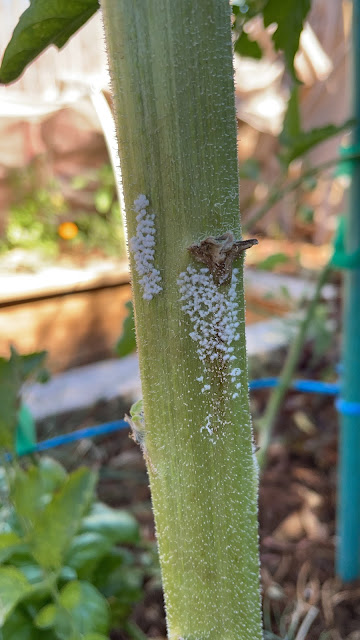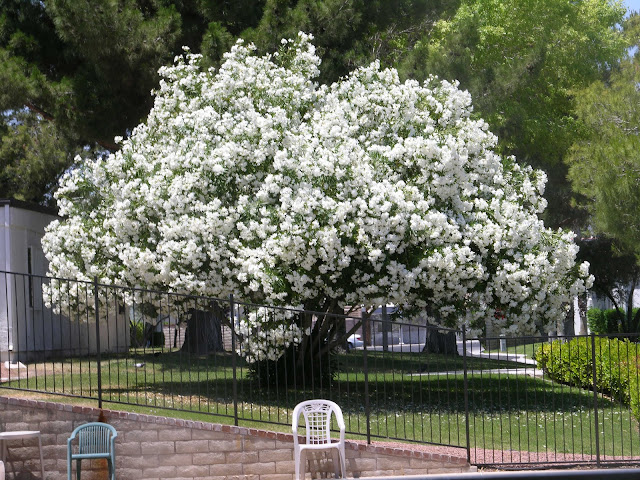Q. What might be happening to our
ash trees? We noticed that a couple of our ash trees are not doing well at
all. I did a quick google search
yesterday and found an article you wrote about ash dieback. I’m hoping that’s
not what is happening to our trees, but it does look like it. The only other
thing that might have happened is that my husband put sterilant down on some
rocks nearby last November. Now we are wondering if perhaps the sterilant made its
way down to tree roots that may have been growing beneath the rocks? I believe he treated the whole area with the sterilant,
and you can see where the tree trunk is located in relation to the rocks. If it is in fact a chemical injury to the
trees, is there anything that can be done?
 |
Ash Decline (disease) or not? Ash Decline looks just like the trees are not getting enough water. You wont know until you water it (give it some extra water) for a few weeks and find out. Unless you want to pay a big plant pathology bill.
|
A. I don’t think your ash tree has
this particular disease. After looking at the pictures you sent, I think it was
caused by the sterilant. It’s helpful if you can tell me the name of the
sterilant used. Many sterilants are taken up by plant roots. The sterilant
damage usually occurs on leaves and stems. On leaves, sometimes they “scorch” (their
leaf margins will burn). This is what I think I see. In many cases the leaves
turn yellow or become “bleached”.
 |
| This is the type of "yellowing" I'm talking about. It is not "sterilant" yellowing but this is the color I am talking about. |
Tree
roots watered by rainfall extend horizontally to about the length of their
height. So, if you roughly (visually) lay the tree on its side and spin a
circle with it, that roughly extends the length of their roots (with rainfall).
 |
| Some pine trees I was given to spray with Dicamba, because we saw some dicamba issues on some pine trees when I worked for Utah State University as a Horticulturist. |
In
the desert tree roots follow water. Wherever water is applied, that's where you
will find its roots if this area is under its canopy. I noticed a lawn under
the tree. Did you kill a part of the lawn with sterilant? Many sterilants are
taken up by plant roots but this sterilant can oftentimes be seen in the
leaves.
 |
| Dicamba was also used as a sterilant. This is what dicamba damage looks like on pine trees. Shout out to my friends in SLC Utah. |
If
it is sterilant damage, you can try a couple of things. First try to wash it
out. It may or may not work. Putting a lot of extra water in that area may flush the sterilant out.
Just remember to give a day or so without water to give a chance for the roots
to "breathe". Roots need both air and water to survive.
There
is a chance that putting activated charcoal (expensive, activated carbon its called and is specific to the sterilant) may help but it depends on the
sterilant used.
When
there is consistent rainfall, roots of trees extend all through the soil under
its so-called “canopy”. Your ash tree grows in a lawn. Watering lawns is more
even, regular, and consistent than rainfall. Ash trees do remarkably well in
lawns. In my opinion that is their preferred way of getting water to the roots.
Ash
trees infected with ash decline are not getting enough water to the dying limbs. This disease plugs the water conducting
vessels in tree limbs. As this disease slowly gets worse, more and more limbs
begin dying because of a lack of water. The homeowner ends up removing the tree
because it looks “ugly”.
To see if your tree has this disease or not,
give it some extra water once a week during the summer! An extra irrigation
during the week tells you if the tree has this disease or not. If the tree does
not improve in a few weeks with this extra irrigation, then assume the tree has
the disease.
The
mistake made by most homeowners, in my opinion, is not removing the tree as
soon as they decide one way or another. If you have confirmed this disease,
then remove the tree as soon as possible. This tree can spread this disease to
other ash trees!

.jpg)
.JPG)



.JPG)

.JPG)
.JPG)

.JPG)

.JPG)

.JPG)







.bmp)


.jpg)

.JPG)
.JPG)